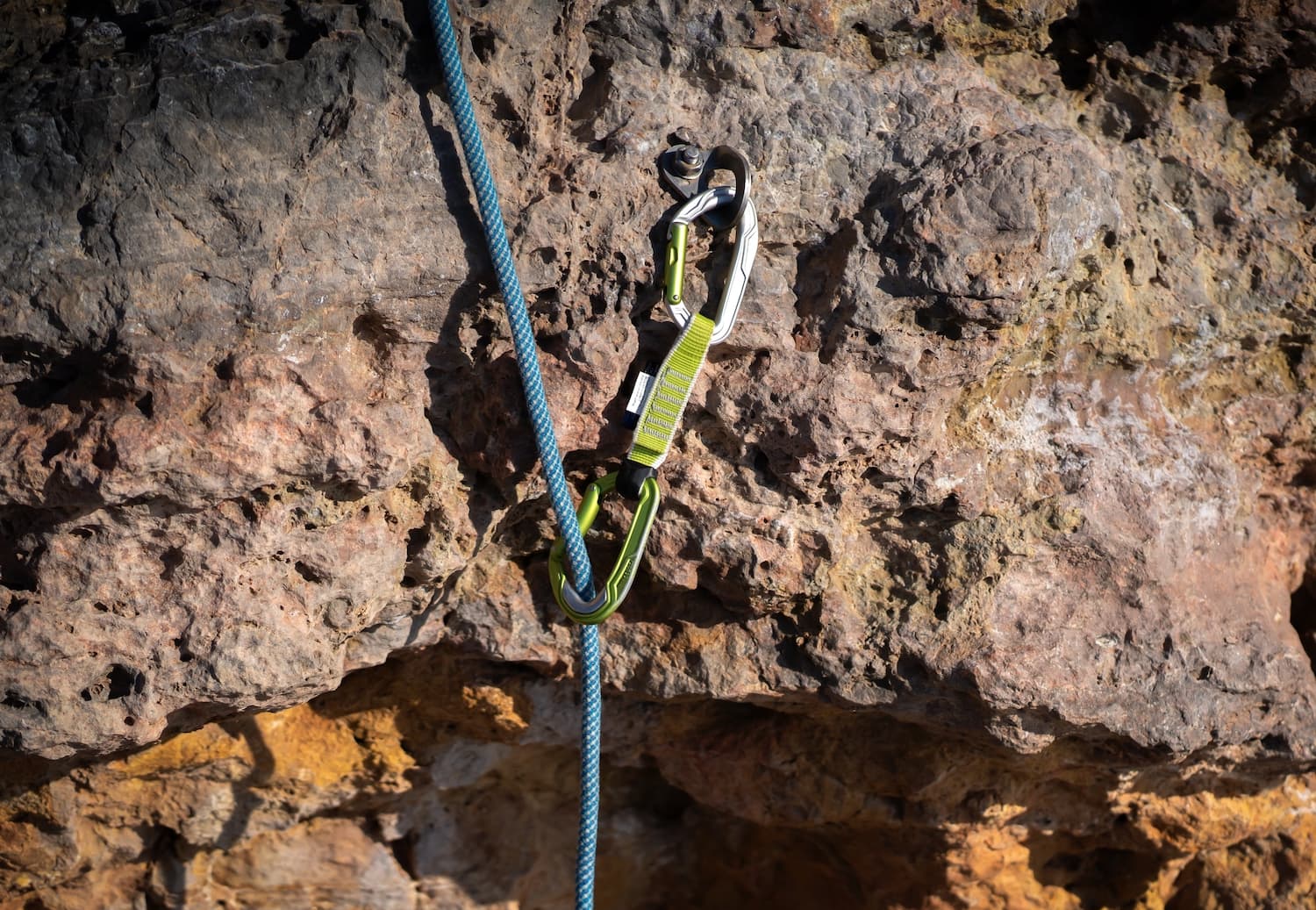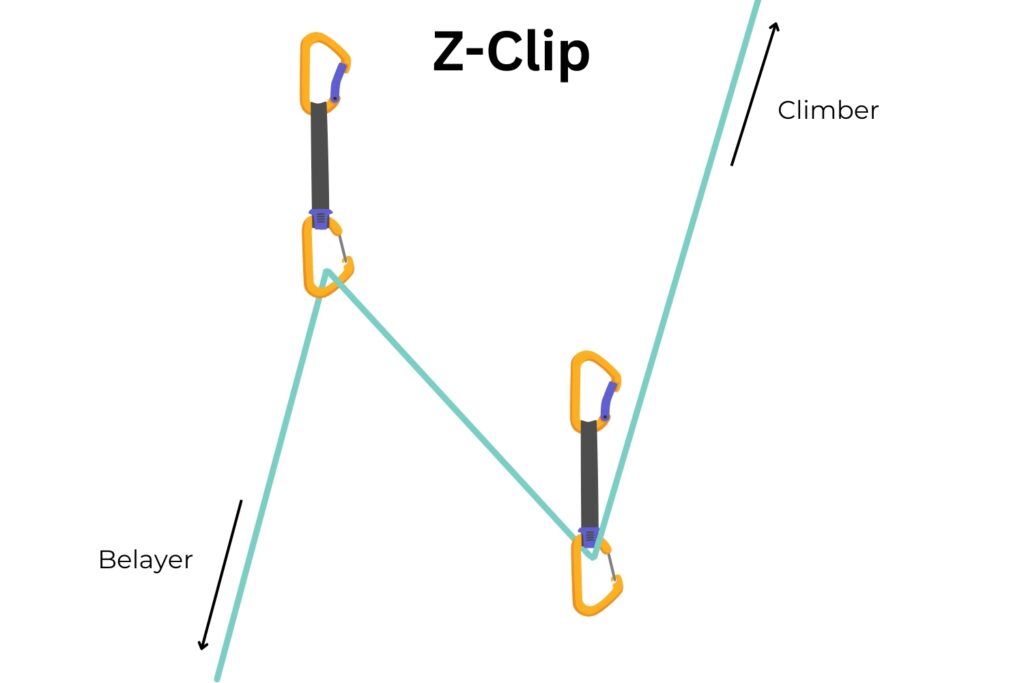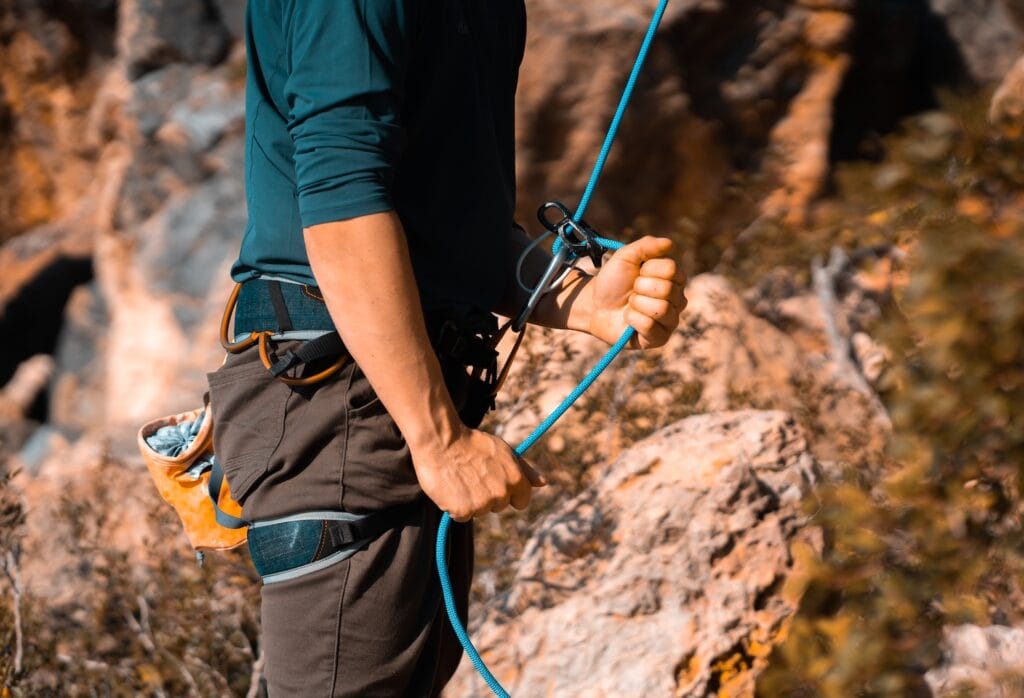Z-Clipping: Why and How to Avoid It (2024 Guide)

Learning to lead climb is an exciting process. However, it should not be taken lightly. That’s because there are many new skills and risk management decisions a leader climber must perform to enjoy themselves while climbing and adequately mitigate the inherent risks of the sport.
One of those risks is the z-clip. Fortunately, like most mistakes, z-clips are preventable, especially if you take the time to learn why it’s a problem and how to avoid it.
So, if you are new to lead climbing and want to learn how to avoid z-clipping, keep reading.

Clipping on Lead
As you spend more time rock climbing and improving your skills, it’s logical for you to progress past top roping and learn how to lead climb on a sport climb.
Lead climbing is when you climb a route without an established top rope. Instead, you lead up the climb, clipping your rope into a series of quickdraws. In the event of a fall, your climbing partner on belay, along with the nearest quickdraw, arrest your fall. Then, when you reach the top of the climbing route, you clip the rope into the anchors and get lowered down.
One of the most critical skills of a sport climber is the ability to efficiently clip their climbing rope into the quickdraws as they ascend the climb. Being able to safely and efficiently clip the rope while leading climbing is important for two reasons.
- The faster you can clip a quickdraw, the faster you can protect yourself from taking a big whipper.
- The faster you can clip a quickdraw, the less time you spend hanging on one arm and expending valuable energy.
But there is a nuance to being able to efficiently and rapidly clip the rope. You also need to do it correctly. One of the ways you can clip the next clip incorrectly is by z-clipping.
What Is Z-Clipping?
Z-clipping is when the lead climber accidentally pulls up the belayer’s strand of rope from below the previous quickdraw to clip the subsequent quickdraw instead of pulling up their climbing strand to clip into the quickdraw.
When a climber is z-clipped, and the climber continues to climb without remedying the situation, the climbing rope forms the shape of a “z” as it weaves up through the highest clip, back down to the lower draw, and up again to the climber’s tie-in knot.

Why Does Z-Clipping Occur?
Z-clipping is most common in indoor climbing. However, it is possible for a climber to z-clip while lead climbing outside also.
But for the most part, z-clipping occurs in the indoor setting for one of two reasons.
- Indoor sport climbing routes have a lot of bolts closely spaced. This provides the opportunity for the climber to mistakenly grab the rope from below the lower quickdraw and clip the rope into the top quickdraw.
- While climbing, it’s natural for a climber to become overly focused on the next clip. This is especially true for beginner climbers. When this occurs, the climber grabs blindly for the rope below them, often grabbing the belay side of the rope and clipping it into the next bolt.
To help demonstrate what z-clips look like in the indoor climbing scenario, I recommend watching this video from Climbing Tech Tips:
Why is Z-Clipping a Problem?
Z-clipping is inherently dangerous and problematic because it introduces extra slack into the climbing system.
A z-clip creates a ton of rope drag. Rope drag makes lead climbing much harder and leaves the climber more susceptible to falling.
But more importantly– creating a z-clip gives the leader a false sense of security.
They assume that because their rope is clipped at a higher point, they are safe from taking a big fall. However, if the leader falls while z-clipped, they won’t get caught on the highest clip. Instead, because of the extra slack in the system, they’ll take a large fall onto the lower of the two clips.
How to Prevent Z-Clips
As you gain more experience, accidentally z-clipping will become less frequent later in your climbing career. However, when you first start climbing, it’ll be important to stay vigilant to avoid accidentally z-clipping.
There are two important ways you can prevent z-clips.
Double Check your Clips
As you get used to leading and the required techniques to properly and efficiently clip your rope, I recommend that you pause and perform a quick double-check after making the clip. Then start climbing again.
Have a Vigilant Belayer
Belayers are not just for arresting falls. They can also prevent z-clips. Having a vigilant belayer who can identify the problem, and perhaps even prevent it before it happens, is super important.

How to Fix Z-Clipping
If you accidentally z-clip, you need to fix the situation to avoid a possibly dangerous fall.
Here are the steps to follow to safely fix a z-clip.
- Maintain your calm and do your best to find a comfortable and secure climbing stance.
- Then, unclip the lower of the two quickdraws. Leave the top quickdraw clipped into the climbing rope.
- Now, take the unclipped quickdraw closest to you and re-clip it into the belay side of the rope.
Depending on the scenario, you may need to downclimb a few moves to fix a z-clip. It’s also worth mentioning that after unclipping the bottom draw, it may be easier to take the belayer’s side of the rope to the quickdraw as opposed to taking the quickdraw to the rope.
Other Mistakes to Avoid on Lead
Z-clipping isn’t the only mistake you should avoid while lead climbing. Below are two more common mistakes that budding lead climbers make that can lead to injury.
Falling with the Rope Behind Your Leg
When most climbers fall while lead climbing the belayer safely arrests the fall, and everything is okay. However, if a climber falls with the rope running behind their leg or foot, their safety becomes drastically compromised.
That’s because the rope can cause the climber to flip upside down, exposing their spine and head to a collision with the wall.
Back Clipping the Rope
Like creating a z-clip, back-clipping is a common mistake that new lead climbers accidentally commit. Back clipping is when you grab the rope and clip it into the quickdraw backward.
In other words, back-clipping is when the climbing strand of the rope that runs down to the climber’s harness is facing inward toward the wall, and the belay strand is facing outward towards the climber.
Final Thoughts
Z-clipping is a common mistake that can compromise the safety of a lead climber, especially those new to lead climbing. Fortunately, z-clipping is preventable.
If you are still learning how to make clips properly, take your time to refine your clipping methods and do a quick double-check at every bolt. Likewise, ask your climbing partners to help identify the problem so you can re-clip if it occurs.

